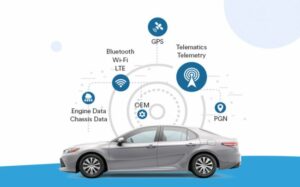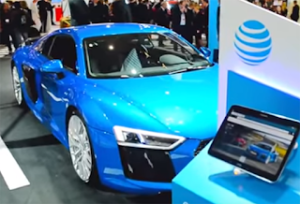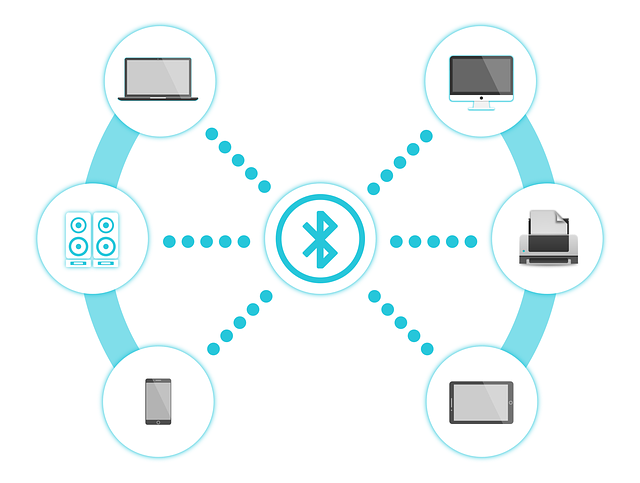History of “connected cars” and future quality
Introduction
In recent years, I have often heard the word “connected car”. Although I’ve heard this word, few people understand what it is and what it can do.

In this article, the author, who was involved in the quality verification of car navigation systems, will explain the history, prospects, and required quality from the already known information on connected cars . ..
What is a “connected car”?
① History so far
A car that functions as an ICT terminal
From the word “connected car”, you may have the image of “a car that can be connected to the Internet and become convenient in various ways.” However, there are still few people who have a clear vision of what a “connected car” specifically means, how far it has progressed, and what will happen in the future
In the Ministry of Internal Affairs and Communications, a “connected car” is a car that functions as an ICT terminal, and various data such as the state of the vehicle and the surrounding road conditions are acquired by sensors and collected and analyzed via a network. It is expected to create new value. ” (From the “2015 White Paper on Information and Communication”) Indeed, it seems that the “connected car” is accurately expressed by listening to it.
Real-time communication service
However, from the viewpoint of “ICT = information and communication function”, it has been “about 30 years before the first GPS car navigation system was born in 1990 (strictly speaking, for the car navigation system installed in the car)”. It is equipped with a “real-time communication function”, and the car navigation set that enables hands-free calling by Bluetooth connection/voice recognition via a mobile phone was first introduced to the market in 2001, that is, about 20 years from now. It was before.
Connected car services of each company
In addition, even in private companies, in 1997, Toyota, Honda, and Nissan had “MONET,” “Internavi,” and “Compass Link,” which are “connected car services,” that is, ” combining a communication system with a mobile device in real-time. ” Service to provide information to ” has started. (Generally, these services are called “telematics services”.) In October 2002, Toyota renewed its telematics services under the name “G-BOOK” and was jointly developed by DENSO / KDDI. Utilizing a dedicated data communication module, we have provided not only drive information such as parking lots, but also information such as news, weather, stock prices, and services such as e-mail and network games.
② Mechanism of connected car
Various sensors to be installed
A connected car is a car that emphasizes the transmission and utilization of information.
The mechanism is very simple, sending information inside and outside the car to the data center through sensors mounted on the car and receiving feedback.
So, in what ways is the information used?
First, there are various types of sensors that collect information, and each has a different role.
For example, image recognition sensors and object detection sensors collect information about the surroundings of the car, and position sensors measure the angle of the accelerator and brakes.
In addition, a battery sensor for power to calculate the mileage is indispensable for EVs (electric vehicles) and VHS (hybrid vehicles).
Utilization of sensor information for safe driving
The information collected from each sensor is transmitted (transmitted) to the data center for analysis.
Since sensors are installed not only in automobiles but also on roads, the amount of information collected in data centers is enormous.
By receiving the analysis results of all the accumulated information, the connected car meets safety standards while driving and improves user convenience.
Specifically, it includes the shortest route guidance based on real-time traffic congestion information, the selection of detours for roads under construction, and the prevention of accidents by sending messages prompting breaks based on the mileage and travel time.
It can be said that this area utilizes transmitted information.
The need for advanced information processing capabilities
In addition, to achieve the goal of increasing the safety of “running cars,” information processing capabilities that enable prompt feedback are essential.
Currently, the platform is independently developed by each automobile manufacturer, and ADAS (advanced driver assistance system) represented by ACC (following driving function) that keeps the distance between vehicles and FCW (advanced driver assistance system) is also such a platform. It is made up of the above.
In other words, by quickly processing a huge amount of information to derive the optimum solution and connecting it to all functions, the connected car has improved safety and convenience.
③ New project promoted by Toyota
The news that Toyota Motor Corolla Sport started selling the new Crown and the new Corolla Sport as the “first connected car” on June 26, 2018, is a new memory. (By the way, although it is complicated, Toyota officially calls it “connected car” instead of “connected car”, but in this paper, the notation is unified as “connected car” to avoid complexity. increase)

However, as mentioned in (1), Toyota had already started telematics services almost 20 years ago.
Collecting the information released so far, the “first connected car” defined by Toyota can be summarized into the following three features.
- A communication module called “DCM” is installed as a standard on all grades from the beginning instead of linking with smartphones.
- “DCM” is connected to the vehicle control network (CAN), where vehicle data can be shared with big data in real-time and functional cooperation can be performed.
Aiming to collaborate with various mobility services such as car-sharing operators and taxi operators in collaboration with the “mobility service platform” that Toyota is developing in-house.
Of these, the point I would like to pay particular attention to is point 2. CAN information is a “vehicle control network”, and the exchange of information is completed within the individual vehicle, but by connecting this data to an ICT terminal, it is provided from each vehicle. The amount of information provided will increase dramatically, and the range of services that can be deployed will also expand significantly.
Services such as uploading CAN information to big data and utilizing it are not new. For example, the US automobile insurance company Progressive has been providing a service called “Snapshot” since 2010 that reflects the number of sudden braking, etc. in the insurance premium by installing a terminal that captures CAN data of the insured’s vehicle. .. However, its use was limited in terms of usage and number of users.
Toyota sells the “Crown” and “Corolla Sport” as the “first connected car” in a series of 1.3 million units a year, which is currently about 10 to 15% of Toyota’s total annual sales. increase. In addition, there are plans to convert almost all models sold in Japan and the United States into “connected cars.” Given that other automobile companies will naturally follow suit, isn’t the rapid “connected car era” coming? I also think that.
④ Random standards, complicated situations
Things are not so easy in the ever-increasing automotive industry. In the future, there is a tendency for large-capacity data to be transmitted in real-time, such as image transmission from in-vehicle cameras, and “BroadR-Reach Ethernet” has come to be mentioned as a new in-vehicle network to replace CAN. The current CAN has a transmission speed of only 1 Mbps, and CAN-D, which is expected to be the successor to CAN, has a transmission speed of only 8 Mbps, while “BroadR-Reach Ethernet” can achieve a transmission speed of 100 Mbps. Until now, it has been adopted mainly by European automobile manufacturers such as BMW Germany, but in Japan as well, Nissan adopted in-vehicle Ethernet for the new leaf in October 2017, and it became a hot topic.
While each automobile manufacturer is rushing to promote new services and platforms, what direction will the automobile industry take in the future as people who are at the center of the industry have multiple standards scattered around? It is not visible, and it seems that the current situation of the automobile industry is that it is running desperately in the “Gori fog”, and that it is the current state of “connected cars”.
What is the quality and safety required for a “connected car”?
What are the required software quality and safety in such a complicated and unpredictable “connected car” field? It seems to be roughly classified into the following 3 patterns.
(1) Function confirmation/quality confirmation of the connection function that has been around for a long time
example
- Bluetooth connection with ICT terminals such as smartphones → Confirmation of functions such as hands-free calling (including voice recognition/call quality confirmation) and music playback in cooperation
- Compatibility verification due to differences in smartphone / OS Ver / global support, etc.
- Emergency call service (Helpnet [Japan] / e911 [North America]) test
- Satellite radio [digital radio] / broadcast wave reception test / playback test for 1Seg, etc.
- Car navigation function verification by actual driving based on map change/traffic law change etc.

(2) Function confirmation/quality confirmation of the connection function introduced at present and will be introduced soon in the future
example
- Apple CarPlay / Android Auto function cooperation confirmation
- New functions of each manufacturer’s standard [Example: Toyota Smart Link] Function confirmation
- Vehicle emergency call system (eCall [Europe], ERA-GLONASS [Russia]) test
- Operational test of “driving support (watching) service for the elderly” developed by insurance companies
- Operation test of taxi dispatch system using smartphone/cloud service etc.
(3) Function confirmation/quality confirmation of connection functions to be introduced in the future
example
- Vehicle-to-vehicle communication (V2V) Road-to-vehicle communication (V2I) (interoperability verification in mutual communication modules, mutual terminals, mutual vehicles, applications)
- Demonstration experiment of automatic driving (ADAS) (“Truck platooning” “Last mile automatic driving” “Automatic valet parking”)
- Actual driving demonstration experiment for utilizing 5th generation mobile communication (5G)
- New mobility service operation test
Of the above, verification of (3) is important and costly. However, both (1) and (2) are still of high importance, and each manufacturer has no choice but to incur large costs in terms of quality assurance.
In the North American and Western markets, the Bluetooth hands-free function by voice recognition has been used daily for more than 10 years, but it has only begun to gradually penetrate Japan (hands-free call use: 11.4%, Bluetooth ). Use of Audio : 16.1% ). On the other hand, among car owners and smartphone users, the rate of using car navigation apps has exceeded 51.8%, and the use of IoT terminals for in-vehicle use is gradually spreading (both are My Voicecom December 2018 ). Monthly survey).
It can be said that the “Connected Car” service, which has been available for decades, has only begun to be recognized and used by users in the latter half of 2010. Once recognized and used, the penetration of users is accelerating.
Additional development costs are a big burden
The three patterns of software quality and safety required in the “connected car” field are as follows.
(1) Function confirmation/quality confirmation of the connection function that has been around for a long
time (2) Function confirmation/quality confirmation of the connection function that has been introduced at the moment and will be introduced soon in the future
(3) Connection function that will be introduced in the future Function check/quality check
For the “old connection functions” classified in (1), users who are accustomed to “connected cars” will be required to have a quality level that is “naturally feasible”. Not only that, you will soon become accustomed to using the “new connection functions” classified in (2), and you will be demanding high quality.
However, in reality, even with the quality assurance of (1) alone, each hardware manufacturer/software manufacturer is still striving to guarantee quality at a great cost. Regarding (2), new usages that the manufacturer did not even anticipate at the product planning stage will appear one after another, and additional development costs will become a heavy burden to proceed with the response. , Etc. are occurring.
“In-vehicle control by smartphone (app)” is also one of the typical functions classified in (2). Volvo, Mercedes-Benz, and BMW have already realized in-vehicle remote control functions using smartphone apps and have been introduced to the market.
On the other hand, in June 2018, a standard called “Digital Key Release” was announced by an organization called Car Connectivity Consortium. By linking with the smartphone app / wireless (NFC), it becomes a standard technical standard for in-vehicle key lock and engine start. In other words, the standard “remote control for smartphone apps” function of each company is already on the market, and in a few years, the standard “remote control for smartphone apps” function will come out.
Expected value due to the spread of connected cars and future challenges
What to expect from a connected car
There are three typical roles and merits of connected cars: improvement of lifesaving rate in the event of an accident, anti-theft effect, and improvement of convenience.
The improved lifesaving rate in the event of an accident
The “emergency call system” that automatically notifies related organizations in the event of an emergency such as an accident or disaster is the main function for improving the lifesaving rate.
In Europe, equipment became mandatory in April 2018 under the name of “eCall”, and in Japan, international standards were introduced in July 2018.
D-Call Net, AACN (Advanced Automatic Collision Notification System), determines the necessity of requesting a doctor helicopter based on an algorithm.
Anti-theft effect
The “Stolen Vehicle Tracking System” can detect abnormalities such as prying doors and notify the owner or remotely stop the engine of a stolen vehicle.
Improved convenience
In addition, by utilizing smartphones equipped with the same ICT function, user convenience will be significantly improved.
For example, air conditioning adjustment before boarding and navigation that does not require in-vehicle search can be realized by linking with the schedule app.
Challenges in the spread of connected cars
On the other hand, because of the IoT-enabled automobiles, the issue of “how to protect the vehicle from cyber-attacks” is always present.
Therefore, it is essential to build a solution that ensures the security of communication.
Trend Micro’s “Trend Micro IoT Security” enables security measures from three directions: in-vehicle, traffic, and back end.
Currently, many people are doing a lot of work in data migration when replacing smartphones.
When buying a new car, the possibility of further data migration work may be considered an issue.
In general, when convenient methods and things appear, it can be extremely inconvenient to lose these useful things even temporarily.
For example, if you have a smartphone at hand, it is easy to look up a little information immediately.
However, some people may have forgotten when they went out and found it very inconvenient when they wanted to do some research on the go.
We cannot deny the possibility that connected cars will have a greater impact on our lives than smartphones.
In addition, the price tends to rise because the processing of huge amounts of data and the computing functions and communication networks required to realize high-speed communication are indispensable.
Due to the inaccessible price range and the complicated operation required due to its multi-functionality, there will be quite a few consumers who are reluctant to introduce it.
summary
To establish the ultimate goal of connected cars, and autonomous driving, it is essential to build and promote the spread of V2X technology represented by V2V and V2I.
Other future issues include data sharing schemes and linkage methods with standardization in mind, rules for infrastructure and vehicle communication protocols, and interfaces that can be operated intuitively regardless of user attributes. Development etc.





